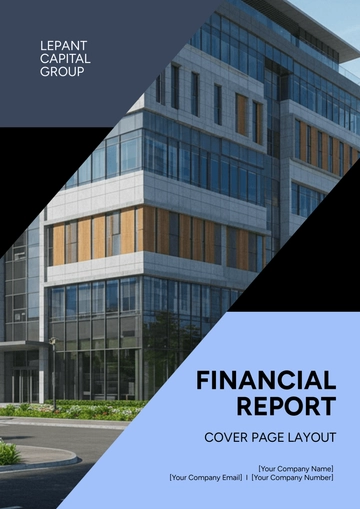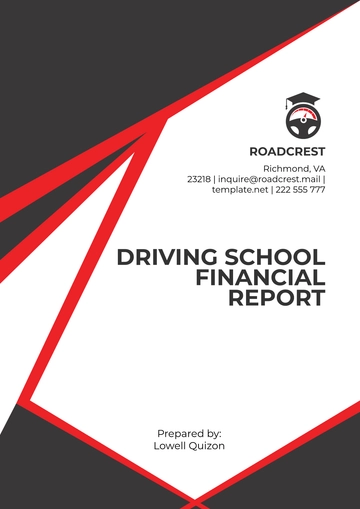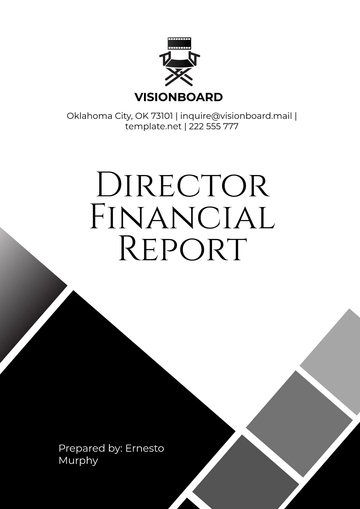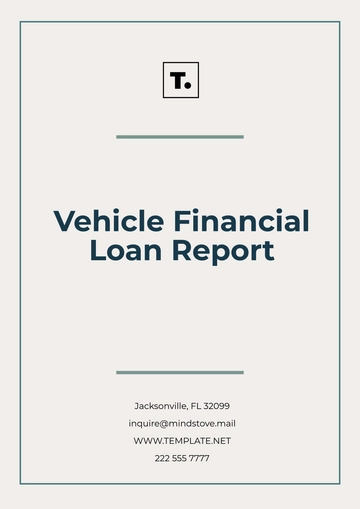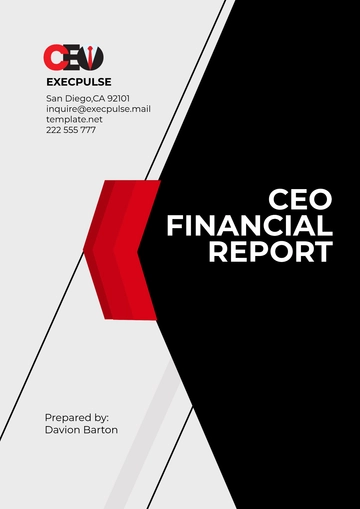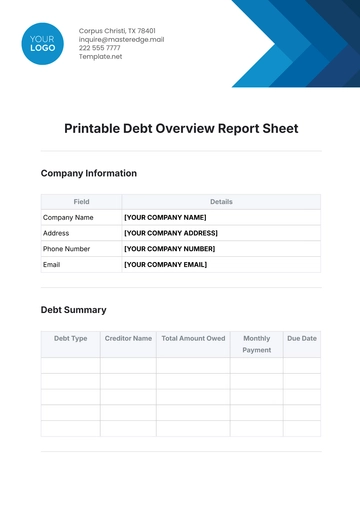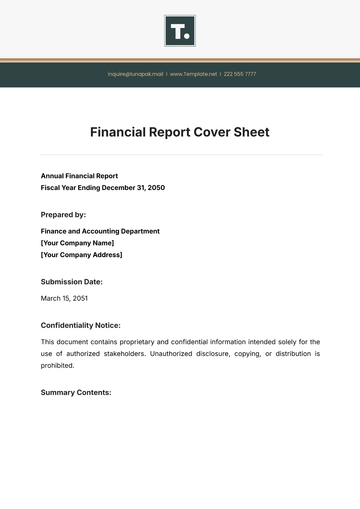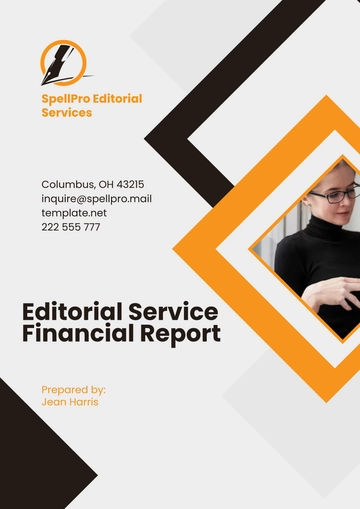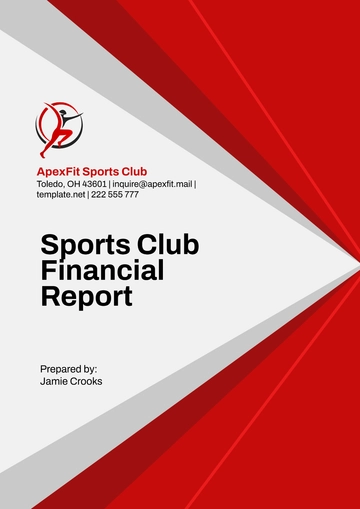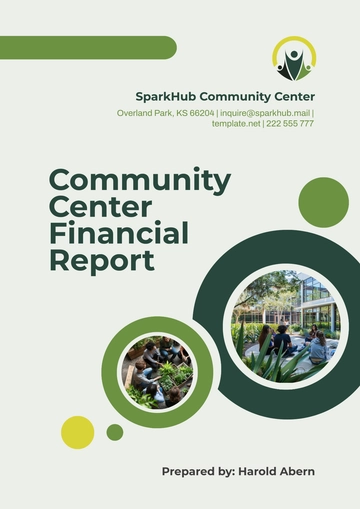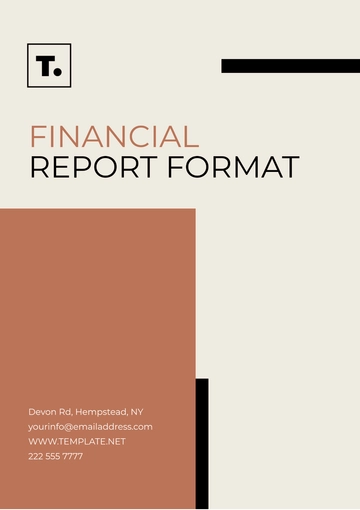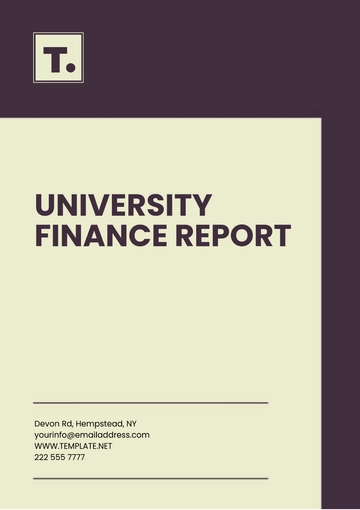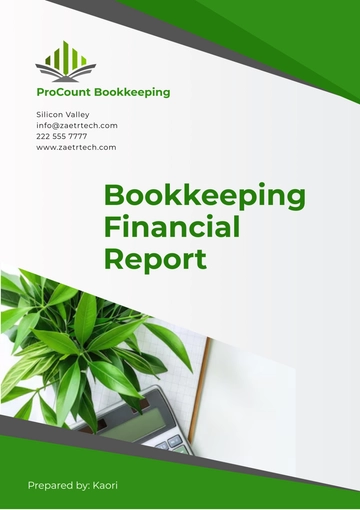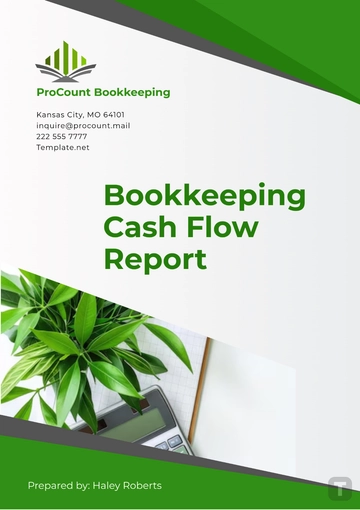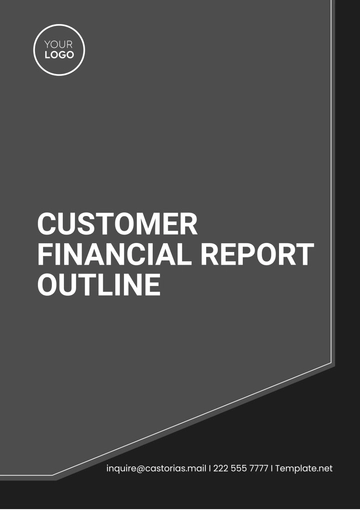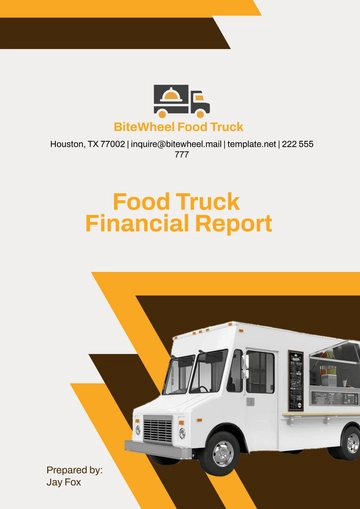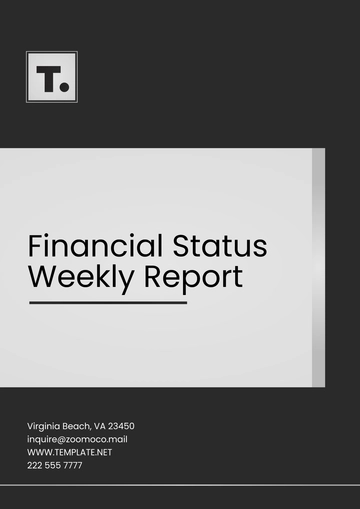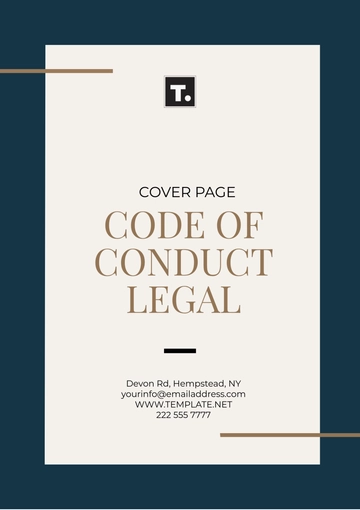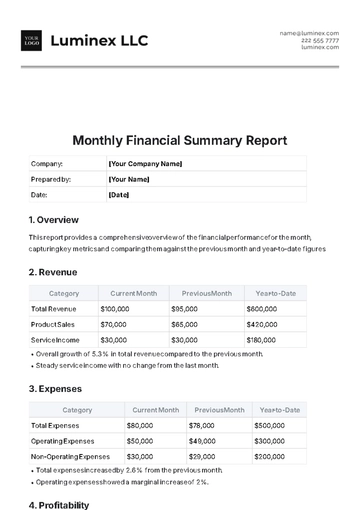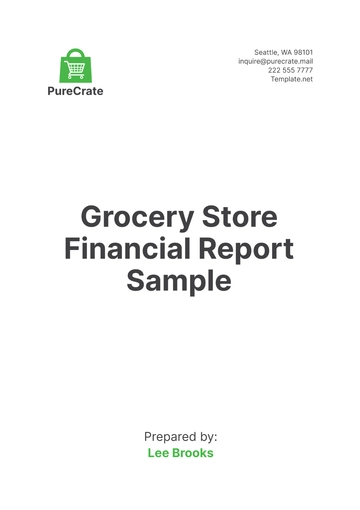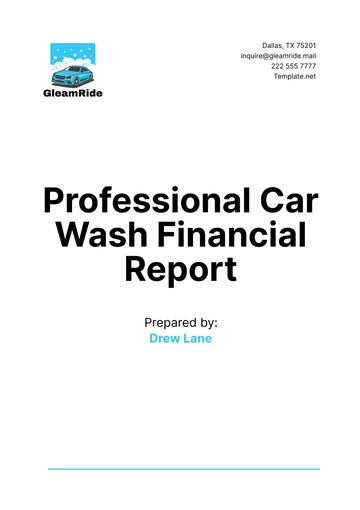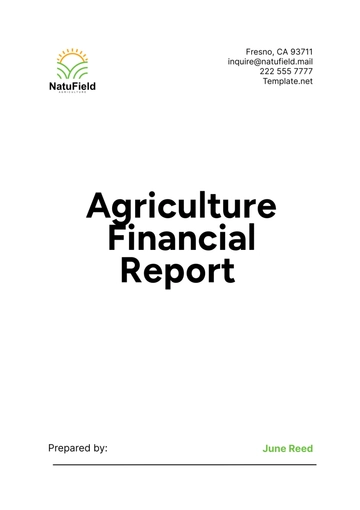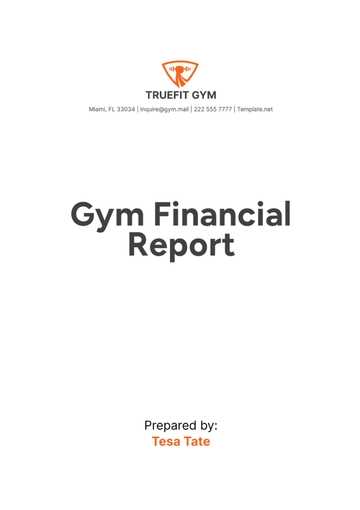Free Agriculture Financial Report
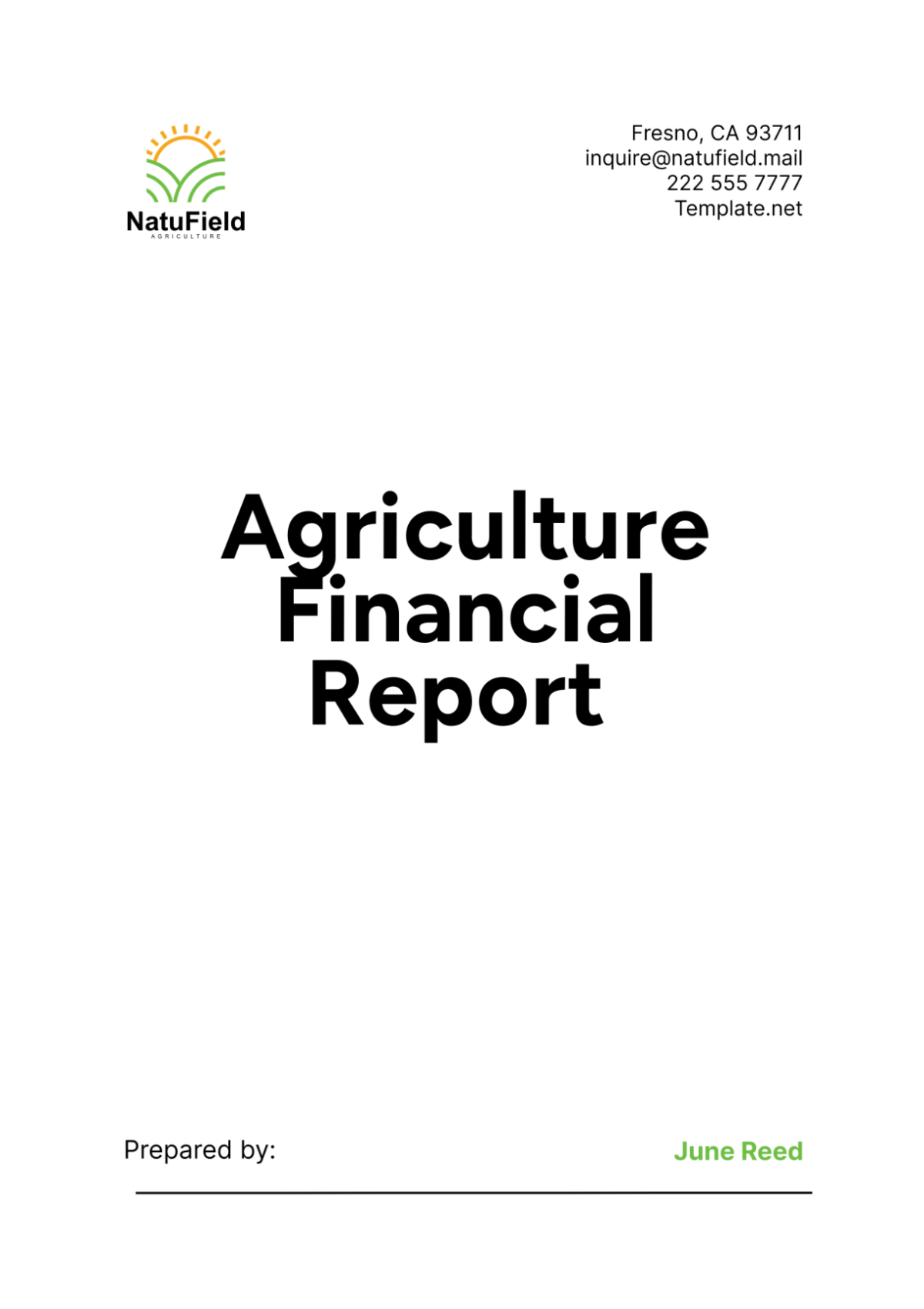
I. Overview
A. Introduction
The Agriculture Financial Report for [Your Company Name] aims to provide a comprehensive analysis of the company's financial performance for the fiscal year ending [Month Day, Year]. This report covers all aspects of the company's agricultural activities, including crop production, livestock management, and associated operations. By presenting detailed financial data and insightful analysis, this report helps stakeholders understand the financial health and sustainability of the company. The key findings highlight significant trends, revenue performance, expense management, and profitability, serving as a foundation for strategic planning and decision-making.
B. Scope
This report encompasses the financial activities of [Your Company Name] from [Month Day, Year], to [Month Day, Year]. It includes detailed analyses of various agricultural operations, such as crop cultivation, livestock rearing, and ancillary services. The report also compares the current financial data with previous periods to identify trends and seasonal variations that impact the company's financial performance. All financial metrics are presented in USD.
II. Executive Summary
A. Financial Performance Highlights
The fiscal year [Year] was marked by significant achievements and challenges for [Your Company Name]. The company recorded a total revenue of $10.5 million, reflecting a 12% increase from the previous year. The profit margins improved from 8% in [Year] to 10% in [Year], driven by effective cost management and enhanced operational efficiency. The net profit for the year stood at $1.05 million, showcasing a robust financial performance despite market volatility and external pressures.
B. Key Financial Ratios
The company's financial stability and profitability are further illustrated by key financial ratios. The current ratio, a measure of liquidity, stood at 2.5, indicating that [Your Company Name] has a strong ability to meet its short-term obligations. The gross profit margin was 35%, while the net profit margin was 10%, reflecting effective cost management and operational efficiency.
C. Major Financial Trends
A year-over-year comparison reveals several significant financial trends. The company's revenue from crop production increased by 15%, while livestock revenue grew by 8%. Seasonal variations played a critical role, with peak revenues recorded during the harvest season from July to October. The company also benefited from favorable market prices for key agricultural products, contributing to the overall revenue growth.
III. Revenue Analysis
A. Total Revenue
The total revenue for [Your Company Name] in [Year] amounted to $10.5 million, up from $9.4 million in [Year]. This growth was primarily driven by increased production volumes and favorable market conditions.
Table: Total Revenue Breakdown
Year | Revenue (USD) | Growth (%) |
|---|---|---|
$9.4 million | 8% | |
$10.5 million | 12% |
B. Revenue by Market Segment
The revenue generated by [Your Company Name] is segmented into domestic and export sales. Domestic sales accounted for $6.5 million, representing 62% of total revenue, while export sales contributed $4 million, or 38% of total revenue. This diversified market approach helps mitigate risks associated with market fluctuations in any single region.
C. Revenue by Product Line
The primary revenue streams for [Your Company Name] include crop production and livestock management. Crop production generated $7 million, while livestock operations contributed $3.5 million.
Table: Revenue by Product Line
Product Line | Revenue (USD) | Percentage of Total Revenue |
|---|---|---|
Crop Production | $7 million | 67% |
Livestock | $3.5 million | 33% |
IV. Expense Analysis
A. Total Expenses
Total expenses for the fiscal year [Year] were $9.45 million, a 10% increase from $8.6 million in [Year]. This rise in expenses is attributed to higher operational costs and increased investment in infrastructure and technology.
B. Cost of Goods Sold (COGS)
The Cost of Goods Sold (COGS) for [Your Company Name] includes direct and indirect costs. Direct costs, such as seeds, fertilizers, and livestock feed, amounted to $4.5 million. Indirect costs, including labor, equipment maintenance, and utilities, were $2.5 million.
Table: Cost of Goods Sold Breakdown
COGS Category | Amount (USD) |
|---|---|
Direct Costs | $4.5 million |
Indirect Costs | $2.5 million |
C. Operational Expenses
Operational expenses encompass labor costs, equipment and maintenance, and utilities and supplies. Labor costs were $1.5 million, equipment and maintenance expenses were $1.2 million, and utilities and supplies totaled $0.75 million.
Table: Operational Expenses
Expense Category | Amount (USD) |
|---|---|
Labor Costs | $1.5 million |
Equipment & Maintenance | $1.2 million |
Utilities & Supplies | $0.75 million |
V. Profit and Loss Statement
A. Income Statement Overview
The income statement for [Your Company Name] for the fiscal year [Year] is summarized below. Gross profit for the year was $3.675 million, and net profit was $1.05 million.
Table: Income Statement Overview
Financial Metric | Amount (USD) |
|---|---|
Total Revenue | $10.5 million |
COGS | $7 million |
Gross Profit | $3.675 million |
Operational Expenses | $2.95 million |
Net Profit | $1.05 million |
B. Quarterly/Annual Comparisons
A comparison of quarterly performance reveals significant seasonal variations. The second and third quarters, coinciding with the harvest season, showed the highest revenues and profits. The first and fourth quarters had lower financial performance due to the off-season.
Table: Quarterly Performance Comparison
Quarter | Revenue (USD) | Gross Profit (USD) | Net Profit (USD) |
|---|---|---|---|
Q1 | $2.2 million | $0.75 million | $0.2 million |
Q2 | $3.0 million | $1.1 million | $0.3 million |
Q3 | $3.5 million | $1.2 million | $0.35 million |
Q4 | $1.8 million | $0.625 million | $0.2 million |
C. Earnings Before Interest and Taxes (EBIT)
Earnings Before Interest and Taxes (EBIT) for [Year] was $1.3 million. This metric highlights the company's operational efficiency and profitability before accounting for interest and taxes.
Table: EBIT Calculation
Metric | Amount (USD) |
|---|---|
Gross Profit | $3.675 million |
Operating Expenses | $2.375 million |
EBIT | $1.3 million |
VI. Cash Flow Statement
A. Cash Flow from Operations
Cash flow from operations reflects the cash inflows and outflows directly related to core business activities. For [Year], cash inflows from operations were $2.8 million, while cash outflows were $1.9 million, resulting in a net cash flow from operations of $0.9 million.
Table: Cash Flow from Operations
Cash Flow Category | Amount (USD) |
|---|---|
Cash Inflows | $2.8 million |
Cash Outflows | $1.9 million |
Net Cash Flow | $0.9 million |
B. Cash Flow from Investing Activities
Investing activities include the purchase and sale of long-term assets. In [Year], [Your Company Name] invested $1.2 million in new equipment and infrastructure improvements. The company also earned $0.3 million from the sale of old equipment, resulting in a net cash outflow of $0.9 million from investing activities.
Table: Cash Flow from Investing Activities
Cash Flow Category | Amount (USD) |
|---|---|
Purchases of Long-term Assets | $1.2 million |
Proceeds from Sale of Assets | $0.3 million |
Net Cash Flow | -$0.9 million |
C. Cash Flow from Financing Activities
Financing activities cover cash flows related to borrowing and repaying loans, as well as equity financing. In [Year], [Your Company Name] raised $1.5 million through new loans and repaid $1.0 million of existing debt. The company also issued equity worth $0.5 million, resulting in a net cash inflow of $1.0 million from financing activities.
Table: Cash Flow from Financing Activities
Cash Flow Category | Amount (USD) |
|---|---|
Proceeds from Loans | $1.5 million |
Repayment of Loans | $1.0 million |
Equity Financing | $0.5 million |
Net Cash Flow | $1.0 million |
VII. Balance Sheet
A. Assets
The balance sheet provides a snapshot of [Your Company Name]'s financial position as of [Month Day, Year]. The assets are divided into current and non-current categories. Current assets include cash and cash equivalents, accounts receivable, and inventories, while non-current assets comprise property, plant, equipment, and long-term investments.
Table: Assets Breakdown
Asset Category | Amount (USD) |
|---|---|
Current Assets | |
Cash and Cash Equivalents | $2.5 million |
Accounts Receivable | $1.8 million |
Inventories | $3.0 million |
Non-Current Assets | |
Property, Plant, and Equipment | $7.5 million |
Long-term Investments | $2.0 million |
Total Assets | $16.8 million |
B. Liabilities
Liabilities are categorized into current and long-term liabilities. Current liabilities include accounts payable and short-term loans, while long-term liabilities comprise long-term debt and deferred tax liabilities.
Table 2: Liabilities Breakdown
Amount (USD) | |
|---|---|
Current Liabilities | |
Accounts Payable | $1.2 million |
Short-term Loans | $1.5 million |
Long-term Liabilities | |
Long-term Debt | $4.5 million |
Deferred Tax Liabilities | $0.8 million |
Total Liabilities | $8.0 million |
C. Equity
The equity section represents the residual interest in the assets of [Your Company Name] after deducting liabilities. It includes common stock, retained earnings, and other comprehensive income.
Table: Equity Breakdown
Equity Category | Amount (USD) |
|---|---|
Common Stock | $4.0 million |
Retained Earnings | $4.5 million |
Other Comprehensive Income | $0.3 million |
Total Equity | $8.8 million |
VIII. Financial Ratios
A. Liquidity Ratios
Liquidity ratios measure the company's ability to meet its short-term obligations. Key liquidity ratios for [Your Company Name] include the current ratio and the quick ratio.
Table: Liquidity Ratios
Ratio | Formula | Value |
|---|---|---|
Current Ratio | Current Assets / Current Liabilities | 2.0 |
Quick Ratio | (Current Assets - Inventories) / Current Liabilities | 1.5 |
B. Profitability Ratios
Profitability ratios assess the company's ability to generate profit relative to revenue, assets, and equity. Important profitability ratios for [Your Company Name] include the gross profit margin, net profit margin, and return on equity (ROE).
Table: Profitability Ratios
Ratio | Formula | Value |
|---|---|---|
Gross Profit Margin | (Gross Profit / Total Revenue) * 100 | 35% |
Net Profit Margin | (Net Profit / Total Revenue) * 100 | 10% |
Return on Equity (ROE) | (Net Profit / Total Equity) * 100 | 12% |
C. Solvency Ratios
Solvency ratios measure the company's ability to meet its long-term obligations. Key solvency ratios for [Your Company Name] include the debt-to-equity ratio and the interest coverage ratio.
Table: Solvency Ratios
Ratio | Formula | Value |
|---|---|---|
Debt-to-Equity Ratio | Total Liabilities / Total Equity | 0.91 |
Interest Coverage Ratio | EBIT / Interest Expense | 6.5 |
IX. Budget vs. Actual Analysis
A. Revenue Budget vs. Actual
The budgeted revenue for [Year] was $10 million, while the actual revenue was $10.5 million, resulting in a positive variance of $0.5 million or 5%. This favorable variance was driven by higher-than-expected crop yields and strong market prices.
Table: Revenue Budget vs. Actual
Category | Budget (USD) | Actual (USD) | Variance (USD) | Variance (%) |
|---|---|---|---|---|
Total Revenue | $10 million | $10.5 million | $0.5 million | 5% |
B. Expense Budget vs. Actual
The budgeted expenses for [Year] were $9 million, while the actual expenses were $9.45 million, resulting in an unfavorable variance of $0.45 million or 5%. This variance was mainly due to unexpected increases in labor costs and equipment maintenance.
Table: Expense Budget vs. Actual
Category | Budget (USD) | Actual (USD) | Variance (USD) | Variance (%) |
|---|---|---|---|---|
Total Expenses | $9 million | $9.45 million | -$0.45 million | -5% |
C. Profit Budget vs. Actual
The budgeted net profit for [Year]was $1 million, while the actual net profit was $1.05 million, resulting in a positive variance of $0.05 million or 5%.
Table: Profit Budget vs. Actual
Category | Budget (USD) | Actual (USD) | Variance (USD) | Variance (%) |
|---|---|---|---|---|
Net Profit | $1 million | $1.05 million | $0.05 million | 5% |
X. Investment Analysis
A. Capital Expenditures
In [Year], [Your Company Name] invested $1.2 million in capital expenditures, focusing on upgrading equipment and expanding infrastructure. These investments are expected to enhance productivity and support future growth.
B. Return on Investments (ROI)
The ROI for the capital expenditures made in [Year] is projected to be 15% over the next five years. This projection is based on increased efficiency, reduced operational costs, and higher production capacity.
Table: Return on Investments
Investment | Amount (USD) | Expected ROI (%) | Payback Period (Years) |
|---|---|---|---|
Equipment Upgrades | $0.7 million | 15% | 4 |
Infrastructure Expansion | $0.5 million | 15% | 5 |
C. Future Investment Plans
[Your Company Name] plans to invest an additional $2 million in [Year], focusing on sustainable farming practices and advanced technology adoption. These investments aim to improve yield quality, reduce environmental impact, and enhance overall profitability.
XI. Recommendations
A. Financial Strategy
To ensure continued financial health and growth, [Your Company Name] should focus on optimizing cost management, diversifying revenue streams, and enhancing operational efficiency. Implementing advanced agricultural technologies and sustainable practices will further support long-term profitability.
B. Risk Management
Effective risk management strategies should be adopted to mitigate financial uncertainties. This includes diversifying crop and livestock portfolios, securing insurance coverage for key assets, and establishing contingency plans for market volatility and climate-related risks.
C. Strategic Initiatives
[Your Company Name] should pursue strategic initiatives that align with market trends and consumer preferences. Investing in organic farming, expanding into new markets, and forming strategic partnerships with suppliers and distributors can drive future growth and profitability.
D. Financial Planning
Continuous financial planning and analysis are crucial for maintaining financial stability. Regularly reviewing and adjusting budgets, monitoring financial performance, and conducting scenario analyses will help [Your Company Name] stay resilient and adaptable in a dynamic market environment.
This comprehensive financial report for [Your Company Name] provides a detailed analysis of the company's financial position, performance, and strategic direction. The insights and recommendations outlined herein are intended to support informed decision-making and sustainable growth for the company in the years ahead.
- 100% Customizable, free editor
- Access 1 Million+ Templates, photo’s & graphics
- Download or share as a template
- Click and replace photos, graphics, text, backgrounds
- Resize, crop, AI write & more
- Access advanced editor
Create detailed financial reports with Template.net's customizable and editable Agriculture Financial Report Template. Leverage the AI Editor Tool for precise and comprehensive reporting. This user-friendly template ensures clear communication of financial performance, enhancing transparency and decision-making in your agricultural operations.
You may also like
- Sales Report
- Daily Report
- Project Report
- Business Report
- Weekly Report
- Incident Report
- Annual Report
- Report Layout
- Report Design
- Progress Report
- Marketing Report
- Company Report
- Monthly Report
- Audit Report
- Status Report
- School Report
- Reports Hr
- Management Report
- Project Status Report
- Handover Report
- Health And Safety Report
- Restaurant Report
- Construction Report
- Research Report
- Evaluation Report
- Investigation Report
- Employee Report
- Advertising Report
- Weekly Status Report
- Project Management Report
- Finance Report
- Service Report
- Technical Report
- Meeting Report
- Quarterly Report
- Inspection Report
- Medical Report
- Test Report
- Summary Report
- Inventory Report
- Valuation Report
- Operations Report
- Payroll Report
- Training Report
- Job Report
- Case Report
- Performance Report
- Board Report
- Internal Audit Report
- Student Report
- Monthly Management Report
- Small Business Report
- Accident Report
- Call Center Report
- Activity Report
- IT and Software Report
- Internship Report
- Visit Report
- Product Report
- Book Report
- Property Report
- Recruitment Report
- University Report
- Event Report
- SEO Report
- Conference Report
- Narrative Report
- Nursing Home Report
- Preschool Report
- Call Report
- Customer Report
- Employee Incident Report
- Accomplishment Report
- Social Media Report
- Work From Home Report
- Security Report
- Damage Report
- Quality Report
- Internal Report
- Nurse Report
- Real Estate Report
- Hotel Report
- Equipment Report
- Credit Report
- Field Report
- Non Profit Report
- Maintenance Report
- News Report
- Survey Report
- Executive Report
- Law Firm Report
- Advertising Agency Report
- Interior Design Report
- Travel Agency Report
- Stock Report
- Salon Report
- Bug Report
- Workplace Report
- Action Report
- Investor Report
- Cleaning Services Report
- Consulting Report
- Freelancer Report
- Site Visit Report
- Trip Report
- Classroom Observation Report
- Vehicle Report
- Final Report
- Software Report
